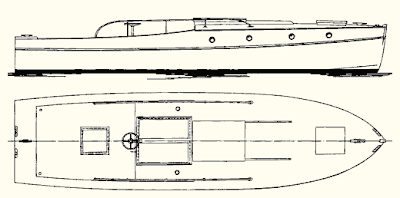This posting originally appeared in my other blog "Building Dark Secret." As that project winds down (it will never be done - it's a wooden boat. Why do they call paint and varnish "finishes," anyway - they are never finished), I am shifting my blogging efforts to a subject near and dear to my heart - an overview of classic yacht designs from the past with an eye toward their usefulness today.
I kick it off with:
"Haven," by William Atkin. Here is the link to the Atkin & Co site for the study plan with the designer's commentary: http://www.atkinboatplans.com/Cruisers/Haven.html
My In-Laws have recently retired. My father-in-law has been talking, in a very what-if kind of way, about building a boat to travel the canal system in New York state, Pennsylvania, and Ohio. He has done a nice job building the fleet of boats that we currently enjoy, but this would be his biggest build. Further clarification of the "mission" is needed but I think Haven could be the perfect boat (with some alteration). She was designed during World War II for aircraft rescue service. Her dimensions are: LOA 29' 9", beam 8', draft 1' 10". Mr. Atkin intended her to have 175 hp (they measured it differently then) and an estimated speed of 35 mph. In the commentary that accompanies his design, he states that the planking is to be two layers of 1/4" plywood. It looks do-able...
As drawn, the open arrangement won't work for an extended trip, even for the most intimate of couples. A simple, rectilinear deck house could transform this easily driven hull into the perfect craft for the task at hand. Something like you'd find on a pre-Depression cruiser like Mer Na.
Clearly one couldn't travel the canal system at 35 mph. Even if you could you wouldn't get to see much along the way, and the fuel costs would put a trip that is already a fantasy squarely in the realm of ridiculous. By installing a 60-80 hp diesel you'll get "lobster boat" speed and she'll sip fuel, not guzzle it. You'd have to build her on a strict diet to keep weight down, particularly in the house. I think I'd build that from something other than teak. As pretty as it is, it's heavy and pricey. Plus, varnish sticks better to mahogany anyway. Plywood could work here, too, but I don't know whether I could go that far. The look is the look. I think bevelled-edge glass is mandatory.
The rudder shown will need re-thinking. As drawn, it looks perfect for a planing hull. At displacement/semi-displacement speeds, she'll need more area. Many of Mssrs. Atkin's power boat designs show an outboard, transom-hung, rudder. I don't think that would be out of place here. There are other advantages that come with this arrangement: simpler (cheaper) fittings, one less hull penetration, easy service without hauling, etc. Scaling off the drawing, it looks like he shows a 14 or 15" prop. I don't know whether we'll get enough out of a wheel of that size. There's another change.
I like the plumb transom, but maybe I'd curve it. I think we crossed a line some time ago - we aren't really talking about the same boat anymore. Let's just call it what it is - a "new" design that draws heavily (to the point of plagiarism?) on the the work of a master from another day. All of these changes add up. If they work well together, then we have to share the credit. If they don't, then we take all of the blame.
Even if you worked a miracle with the interior arrangement, I doubt you'd be able to cram in anything more than a head compartment, two comfortable seats (long and wide enough to nap), and some stowage. With only 4' 5" of headroom, a galley down there is out of the question. Is there enough room in that wheelhouse for a galley? Perhaps. The engine box would make things difficult.
A comment from the previous posting of this item asked "Why not an outboard?" The more I think about it, the more it makes sense. As long as it can be built into an enclosure that doesn't look like an afterthought, and that truly works to quiet things down, then the space lost in the cockpit can be more than offset by the space gained in the wheel house. One of my concerns with removing the inboard diesel from its position amidship was the corresponding movement of the center of mass. Without an engine box in the wheel house, one could build a real and functional galley along one side with a small dinette/chart table aft of the helm. The weight of the joinery, and systems will put her center right back where it belongs. At this point, I think we need to start with a fresh clean sheet of vellum and draw what we want from the get-go. Even on the strictest of weight management programs, we have at least doubled her designed displacement. Getting all of that "stuff" to float on that relatively narrow, easily driven bottom is a no-go. We can keep the roughly 4:1 length:beam ratio (which is part of her appeal to me), but we'll have much more draft. We can keep the shallow draft, but end up with more beam.
In short, if Haven (or her proposed evil fraternal twin) is the answer to the un-asked question, then the voyage will have to be structured around the above-noted limitations. Day-trips from B&B to B&B will be the key to success, comfort, and marital bliss. An occasional overnight aboard can add some adventure.
Will any of this happen? Highly unlikely. Will I be excited to help it become a reality? You bet!!!
So ends the first of what I hope to be many postings like this.


